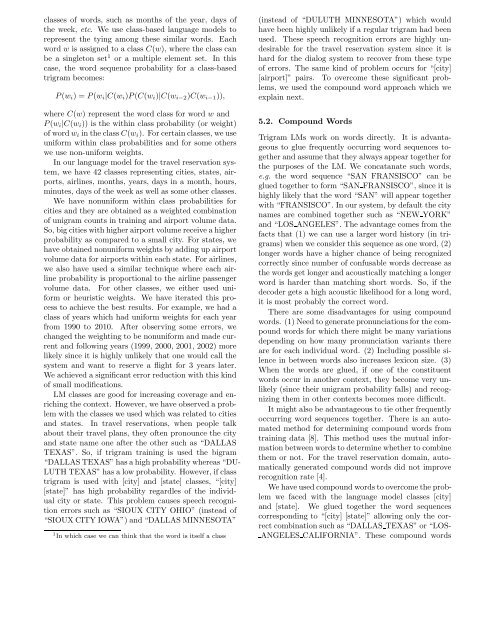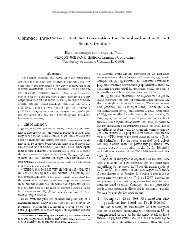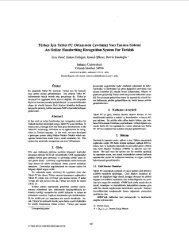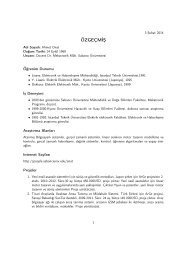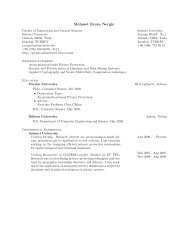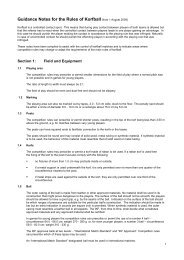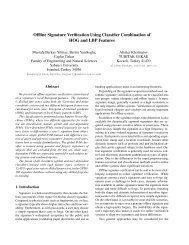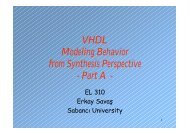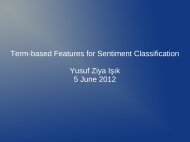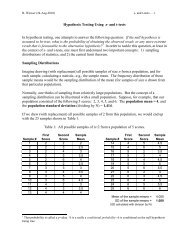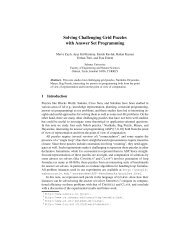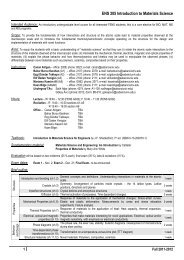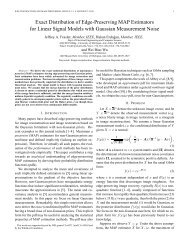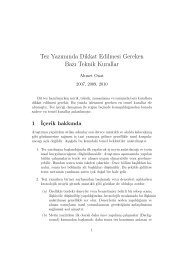SPEECH RECOGNITION FOR A TRAVEL RESERVATION SYSTEM ...
SPEECH RECOGNITION FOR A TRAVEL RESERVATION SYSTEM ...
SPEECH RECOGNITION FOR A TRAVEL RESERVATION SYSTEM ...
You also want an ePaper? Increase the reach of your titles
YUMPU automatically turns print PDFs into web optimized ePapers that Google loves.
classes of words, such as months of the year, days ofthe week, etc. We use class-based language models torepresent the tying among these similar words. Eachword w is assigned to a class C(w), where the class canbe a singleton set 1 or a multiple element set. In thiscase, the word sequence probability for a class-basedtrigram becomes:P (w i ) = P (w i |C(w i )P (C(w i )|C(w i−2 )C(w i−1 )),where C(w) represent the word class for word w andP (w i |C(w i )) is the within class probability (or weight)of word w i in the class C(w i ). For certain classes, we useuniform within class probabilities and for some otherswe use non-uniform weights.In our language model for the travel reservation system,we have 42 classes representing cities, states, airports,airlines, months, years, days in a month, hours,minutes, days of the week as well as some other classes.We have nonuniform within class probabilities forcities and they are obtained as a weighted combinationof unigram counts in training and airport volume data.So, big cities with higher airport volume receive a higherprobability as compared to a small city. For states, wehave obtained nonuniform weights by adding up airportvolume data for airports within each state. For airlines,we also have used a similar technique where each airlineprobability is proportional to the airline passengervolume data. For other classes, we either used uniformor heuristic weights. We have iterated this processto achieve the best results. For example, we had aclass of years which had uniform weights for each yearfrom 1990 to 2010. After observing some errors, wechanged the weighting to be nonuniform and made currentand following years (1999, 2000, 2001, 2002) morelikely since it is highly unlikely that one would call thesystem and want to reserve a flight for 3 years later.We achieved a significant error reduction with this kindof small modifications.LM classes are good for increasing coverage and enrichingthe context. However, we have observed a problemwith the classes we used which was related to citiesand states. In travel reservations, when people talkabout their travel plans, they often pronounce the cityand state name one after the other such as “DALLASTEXAS”. So, if trigram training is used the bigram“DALLAS TEXAS” has a high probability whereas “DU-LUTH TEXAS” has a low probability. However, if classtrigram is used with [city] and [state] classes, “[city][state]” has high probability regardles of the individualcity or state. This problem causes speech recognitionerrors such as “SIOUX CITY OHIO” (instead of“SIOUX CITY IOWA”) and “DALLAS MINNESOTA”1 In which case we can think that the word is itself a class(instead of “DULUTH MINNESOTA”) which wouldhave been highly unlikely if a regular trigram had beenused. These speech recognition errors are highly undesirablefor the travel reservation system since it ishard for the dialog system to recover from these typeof errors. The same kind of problem occurs for “[city][airport]” pairs. To overcome these significant problems,we used the compound word approach which weexplain next.5.2. Compound WordsTrigram LMs work on words directly. It is advantageousto glue frequently occurring word sequences togetherand assume that they always appear together forthe purposes of the LM. We concatanate such words,e.g. the word sequence “SAN FRANSISCO” can beglued together to form “SAN FRANSISCO”, since it ishighly likely that the word “SAN” will appear togetherwith “FRANSISCO”. In our system, by default the citynames are combined together such as “NEW YORK”and “LOS ANGELES”. The advantage comes from thefacts that (1) we can use a larger word history (in trigrams)when we consider this sequence as one word, (2)longer words have a higher chance of being recognizedcorrectly since number of confusable words decrease asthe words get longer and acoustically matching a longerword is harder than matching short words. So, if thedecoder gets a high acoustic likelihood for a long word,it is most probably the correct word.There are some disadvantages for using compoundwords. (1) Need to generate pronunciations for the compoundwords for which there might be many variationsdepending on how many pronunciation variants thereare for each individual word. (2) Including possible silencein between words also increases lexicon size. (3)When the words are glued, if one of the constituentwords occur in another context, they become very unlikely(since their unigram probability falls) and recognizingthem in other contexts becomes more difficult.It might also be advantageous to tie other frequentlyoccurring word sequences together. There is an automatedmethod for determining compound words fromtraining data [8]. This method uses the mutual informationbetween words to determine whether to combinethem or not. For the travel reservation domain, automaticallygenerated compound words did not improverecognition rate [4].We have used compound words to overcome the problemwe faced with the language model classes [city]and [state]. We glued together the word sequencescorresponding to “[city] [state]” allowing only the correctcombination such as “DALLAS TEXAS” or “LOS-ANGELES CALI<strong>FOR</strong>NIA”. These compound words


